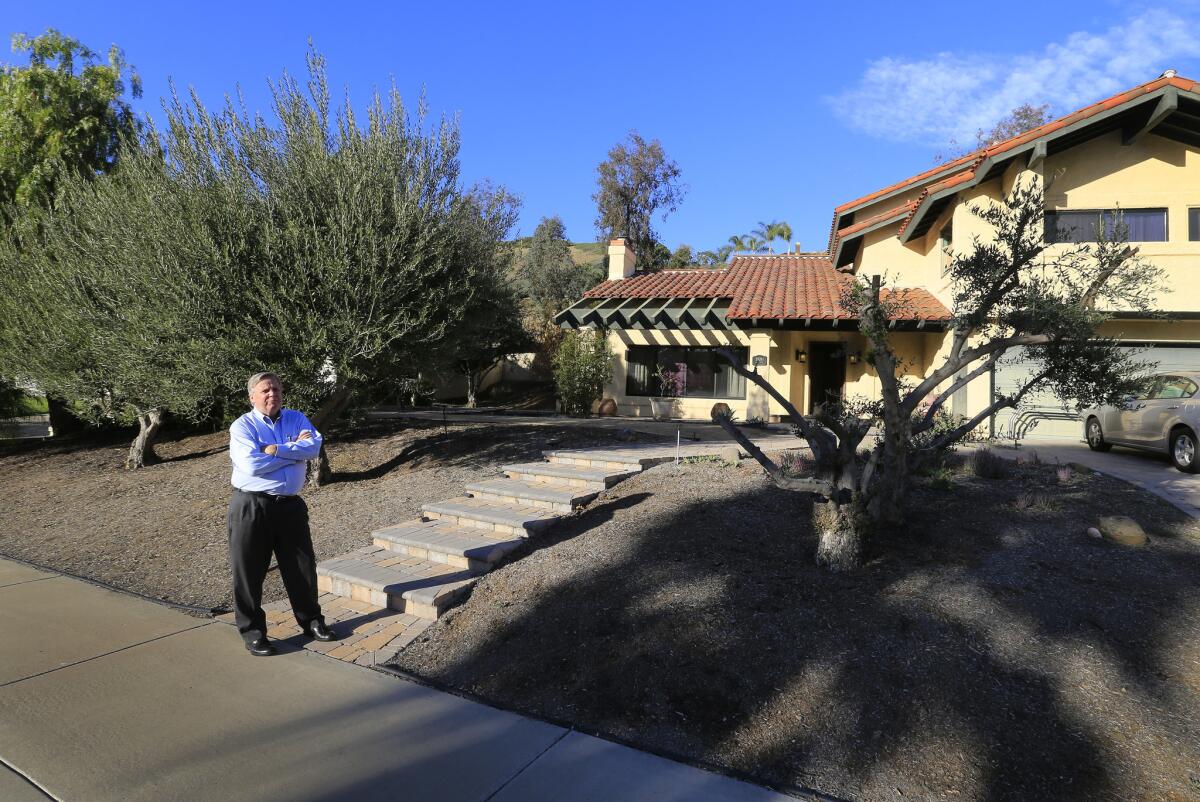Opinion: No more tiers? San Juan Capistrano ruling need not end structured water rates

San Juan Capistrano rate payer Jim Reardon is part of the water rate structure lawsuit against the city’s water agency.
Monday’s state appeals court ruling striking down one city’s tiered water rates could, in a worst-case scenario, mean the eventual collapse of all similar rate structures in California, and with them the collapse of the most proven and effective way of getting people to conserve water through the ongoing drought.
As The Times noted in a recent editorial, this much-anticipated ruling could undermine the state’s water-management strategy. It pits against each other two competing strains of conservative theory -- that water rates should be set by the market (with suppliers taking scarcity into account as they see fit) and that government shouldn’t increase rates unless it has increased costs (and cannot take scarcity into account).
But hold on. The end of tiered rates and water bill sticker shock for guzzlers is by no means inevitable, even under Monday’s 4th District Court of Appeal ruling in a suit brought by a group of rate-payers in the Orange County city of San Juan Capistrano.
The court did not invalidate rate tiers or higher per-unit rates for greater use. It merely ruled that the price of the water had to reflect the cost of delivering it. Sure, if the cost of delivering the first gallon is the same as the cost of delivering the millionth gallon, the public water agency can’t charge more for the last gallon than the first. But what if the cost of that last gallon is indeed more?
Using a baseball metaphor, the court said the San Juan Capistrano water agency had whiffed at the plate -- or, more to the point, in its legal briefs -- when dealing with this key issue. By the way, when the court says ccf, it means 100 cubic feet of water, which works out to 748 gallons:
“In supplemental briefing prior to oral argument, this court pitched a batting practice fastball question to City Water, intended to give the agency its best chance of showing that the prices for its various usage tiers, particularly the higher tiers ... corresponded with its actual costs of delivering water in those increments. We were hoping that, maybe, we had missed something in the record that would demonstrate the actual cost of delivering water for usage over 34 ccf per month really is $9.04 per ccf, and City Water would hit our question into the upper deck.
“What we got back was a rejection of the very idea behind the question. As would later be confirmed at oral argument, City Water’s answer was that there does not have to be a correlation between tiered water prices and the cost of service.”
Sorry, the court told City Water (its term for the San Juan Capistrano water agency), but under California’s Proposition 218, a 1996 tax initiative, there does indeed have to be such a correlation. It is not enough to balance the tax requirement against a different, older provision of the state Constitution that requires conservation of water as a precious natural resource.
The justices did have in front of them amicus (“friend of the court”) briefs that attempted to establish that it costs more to deliver the millionth gallon than the first. If the supplier has to build out a system that is capable of delivering enough water to meet the requirements of large users, or it has to pay more to wholesalers to get more water, the amici argued, then of course it costs more to deliver more water.
The court agreed that if the water agency demonstrates that increased cost, higher rates for bigger users would be fine and, in fact, a “good idea.” But Proposition 218 “does require they figure out the true cost of water, not simply draw lines based on water budgets.”
So now what? California’s 4th Appellate District covers Orange, San Diego, Imperial, San Bernardino and Riverside counties, but unlike in the federal court system, the ruling of a court in one geographic district applies statewide. Appeal to the California Supreme Court is likely, but a state high court ruling will require months of briefing. Meanwhile, water agencies will attempt to limit the San Juan Capistrano ruling to the specific facts of the case -- and will try to show that their price tiers are correlated to the costs of delivery.
Does this ruling apply to wholesale rates that agencies such as the Metropolitan Water District of Southern California (generally known as the Met) charge to their customer members such as the Los Angeles Department of Water and Power? It may not -- and if it doesn’t, the DWP could reasonably argue that in setting tiered rates it is merely passing on the higher cost of water charged by its wholesaler for incrementally higher usage.
But that question is likely to be answered definitively only after court proceedings that could last through many more years of drought.
In the meantime, steep rate tiers that the Metropolitan Water District charges to its customer members really are its only way to limit water use. The Met’s leaders speak about “rationing” their available supply, but there really is no such thing; only price-based incentives. Meeting with the Times editorial board this month, Met General Manager Jeff Kightlinger said his agency doesn’t have a switch or a valve it can turn to block deliveries to members that have exceeded any water quota.
So, if the San Juan Capistrano ruling is taken to its extreme, and if water agencies can’t demonstrate any greater incremental cost for delivering more water, perhaps the only way to manage the dwindling supply is to let it run out.
Or call water rates a tax and ask local voters, district by district, city by city, to validate tiered water rates, and hope they can muster a two-thirds supermajority.
Or amend the state Constitution, one more time, to allow water resource management to trump the 1990s tax measure -- and hope that by the time this dysfunctional, Constitution-bound state gets around to it, there’s still enough water left for the survivors to raise a glass in a bittersweet victory toast.
By the way, how many headlines have classic rock and oldies Top 40 provided for the San Juan Capistrano story? As tiers go by. Tiers on my pillow. Tracks of my tiers. Tiers of a clown.
Follow me @RGreene2
More to Read
A cure for the common opinion
Get thought-provoking perspectives with our weekly newsletter.
You may occasionally receive promotional content from the Los Angeles Times.











